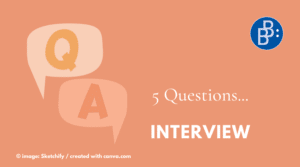Of Bibles & Bunnies
German goldsmith, Johannes Gutenberg, is generally credited with inventing the first modern printing press around 1440 – 1445. His was a project to make the Bible more generally available. It would surprise many that records show Chinese block printing pre-dating him by over 2000 years. Both the Chinese and Gutenberg methods set the stage for the mass production of readable materials, shifting part of the responsibility of the powerful pen (or quill) from author to publisher.
Switching from the individual to the printing press required new attention to accuracy, as once mass-produced, there were no easy erasures nor edits. As a publisher with a very different audience than Gutenberg, Playboy CEO Scott Flanders, at the head of the most recognised publishing brand in the world, remarked more than 550 years later: “Print remains the signature of authenticity. By the time a written word enters the printing press, it has been edited, re-edited and proofread by a string of capable people.”
Flanders, of course, was commenting during a period of similar monumental paradigm shifts as was Gutenberg’s, namely when digital printing and platforms started returning the challenge of credibility to the individual author.
The basic economics of publishing
As academics vie to have their scientific research accepted for publication in scholarly journals, changes in the business models of scholarly presses have resulted in authors now more frequently being charged some fee or the other. It is useful to understand the cost structure faced by these publishers to be able to discern between reputable publishers and a new genre of pay-to-publish operators with all kinds of publishing fees, and what some academic commentators call predatory journals.
Publishing is a remarkably quirky kind of production process with equally quirky economics. You will find that printers want to show you their factories. They love the large, beautifully crafted machines and the floors from which you could eat your breakfast. Rolls of gigantic paper stock dwarf the workers. Yet, while publishing is by no means rocket science in terms of complexity, it is remarkably easy to get wrong. In part, because of cost theory and the need for scale. Open access digital distribution, of course, escapes some production charges.
In lay terms, think of there being large upfront costs to get ready for the first copy of a publication coming off the printing press: authors, editorial boards and in-house editors, artists, designers and proof-readers; pre-production burning of plates for colour and many human hours of toil. Even the rental of the factory space is included. Then comes the distribution and marketing costs. All of these costs have to be met just to get that very first copy printed, whether it is an academic journal, book, magazine or newspaper.
Barbara Budrich, publisher of several reputable Social Sciences journals, points out that when it comes to “their well-loved journals”, authors, peer reviewers and editorial boards often contribute their time at no charge, thus helping to lower costs.
Now, with the first copy printed, every next copy requires just a smidgen of paper, ink and machine micro-seconds, yet it will attract exactly the same revenue as the first, very expensive copy. Therefore, the more of these next, very low-cost copies that can be printed and sold, the better the chance of not only recouping the upfront cost but actually exceeding that mark and making some profit. Calculating that breakeven point and managing to sell that amount of copies (plus one), is where things can go pear-shaped. Commercial printers manage that breakeven point carefully. Academic journals and books face a no different set of choices. Costs have to be recovered one way or the other, and if libraries are cutting their subscription budgets, where should they turn?
The author’s perspective
Every academic field has its well-known A-list of journals, central to research in the discipline and the first prize when it comes to scholarly recognition. You should find them on the shelf of your research library (or more often dog-eared in an equally ambitious colleague’s office!), yet when it comes to the highly specialized and smaller journals, the Dean of Libraries at Colorado State University warns: “… the economic model for academic journal publications is broken. As scholars are handicapped by limited access to the corpus of research in their fields, scientific progress is restricted and slows, and society ultimately loses.” It has become unaffordable for many research libraries to carry subscriptions to every journal requested by their communities. Hence, publishers started turning to new revenue streams – targeting ambitious young academics who need to publish.
As a potential author, it is unlikely that any A-list journal will ask you to spend money for manuscript submission, yet many journals have introduced submission fees that can be quite hefty, with reports of between $300 – $500 at some.
Peer review, performed at its highest standard, exemplifies the best of academic collegiality and shared research, and the quality feedback received from fellow researchers in the field may be invaluable. It is a time-consuming process, admittedly, yet so much part of academia, that one should have some healthy scepticism towards journals that charge a peer review fee. It is so against the spirit of the whole enterprise of research and scholarly communication.
Open access journals recover some cost through subscribe to open or membership fees, but also turn to authors to pay article process charges. Open access advocates argue that if cost should be recovered to sustain this sharing, while maintaining some form of quality, that the submission point is preferable, rather than the distribution side, as that would diametrically oppose the central tenet of the model. Innovative models, aimed at escaping the “predatory” moniker, aim to reduce the pricey fees (some reported up to $5,000) by offering authors a one-time fee of $299 to use their platform.
Find your publisher
The Covid-19 pandemic has reshaped many norms and practices. It also affected budgets at university libraries, exactly at the stage where off-campus work by researchers put much higher demand on their services. As with any major disruptive event, the economic model for publishing is under scrutiny and in flux.
As an emerging academic, understanding how important it is to your career progression to find reputable outlets to communicate your research, you are best off finding a specialist niche publisher with a high reputation in your discipline, and with a personable approach to partner with you in navigating the tough choices on how to publish.
If ever there was a good time to feel that you had a friend in your publisher, this is it …
© Pexels 2022 / image: Anna Nekrashevich

